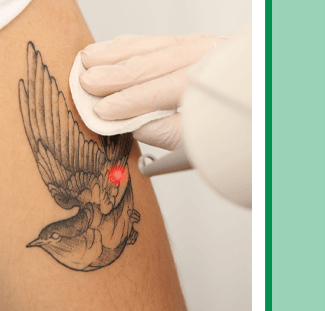
Laser tattoo removal is a leading-edge procedure designed to help people reclaim their skin by effectively reducing the visibility of unwanted tattoos. Utilizing advanced laser technology, this procedure works by breaking down tattoo ink particles deep within the skin, allowing the body to naturally eliminate them over time. With a range of lasers tailored for different ink colors and skin types, laser tattoo removal is recognized as the most efficient method available today, ensuring a safer and more successful experience for patients.
Through a personalized treatment plan and expert care, achieving clearer skin has never been more attainable.
Laser tattoo removal is a medical procedure designed to reduce the visibility of unwanted tattoos. It works by breaking down the tattoo ink particles in the skin using light energy, allowing the body to naturally clear them over time. This is considered the most effective method for tattoo removal, with newer laser technologies improving both the safety and success rates of the procedure.
Tattoo ink sits in the deeper layers of the skin (the dermis). The energy from a laser targets the ink particles, heating them up and causing them to shatter into smaller fragments. These fragments are then removed by the body’s immune system.
Multiple sessions are usually required because the ink needs to be broken down layer by layer. The total number of treatments varies depending on factors such as the size, color, and age of the tattoo, as well as your skin type and the type of ink used.
Common Devices Used for Tattoo Removal:
1. Q-Switched Lasers:
These are the most commonly used lasers for tattoo removal. They deliver short, high-energy pulses that target the ink particles without damaging the surrounding skin.
Laser: Best for darker colors like black and blue. It’s one of the most popular lasers for tattoo removal because it can treat different skin tones and penetrate deeply into the skin.
2. Picosecond Lasers:
These lasers emit shorter bursts of energy compared to Q-Switched lasers, making them more efficient in breaking up tattoo ink particles. Picosecond lasers are effective on a wide range of colors, including traditionally difficult colors like greens and blues.
4. Aftercare:
5. Multiple Sessions:
While laser tattoo removal is generally safe, there are some potential side effects:
Laser tattoo removal has come a long way in terms of safety and effectiveness. Patients should understand that while complete removal is possible, some tattoos may only fade partially. Each tattoo is unique, and factors like color, depth, and age of the tattoo will influence the number of treatments needed. It’s important to consult a certified professional to assess your individual case and determine the best course of action.
By choosing the right technology and following the recommended aftercare steps, patients can experience successful tattoo removal with minimal side effects.